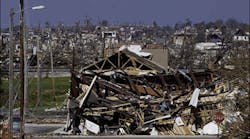In 2013, there were seven weather and climate disaster events with losses exceeding $1 billion each across the United States.
These events included five severe weather and tornado events, a major flood event and the western drought/heat wave. Overall, these events killed 109 people and had significant economic effects on the areas impacted. This year, we’ve experienced severe cold, record snowfalls, record rainfalls and mudslides, among other weather disasters.
During National Severe Weather Preparedness Week, March 2-8, OSHA, the National Oceanic and Atmospheric Administration (NOAA) and the Federal Emergency Management Agency (FEMA) will highlight the importance of preparing for severe weather before it strikes.
Being prepared for severe weather doesn’t have to be complicated or expensive. A few simple steps, such as having a disaster supplies kit, could help save your life.
Tornadoes can occur with little or no warning. Taking precautions in advance of the storms, such as developing an emergency plan, learning the warning signs, and monitoring tornado watches and warnings, can help you stay safe if a tornado occurs in your area.
OSHA and NOAA are working together on a public education effort aimed at improving the way people prepare for and respond to severe weather. This page is designed to help businesses and their workers prepare for tornadoes, and to provide information about hazards that workers may face in the aftermath of a tornado.
To prepare for a tornado, businesses should develop an emergency plan. The plan should include details on suitable places to take shelter, policies to ensure all personnel are accounted for and procedures for addressing any hazardous materials that are on-site. It also is recommended that individuals develop action plans for their families.
The Checklists and Additional Resources pages offer a simple way to make sure that you are prepared for a tornado, including suggestions for communications equipment and personal preparedness kits.
Hazards for Workers
After a tornado has occurred, as businesses take steps to recover from the storm, workers may face significant hazards including the potential for additional storms, downed electric lines, and sharp debris. Workers should also be aware of hazards from heat stress and from equipment used during response/recovery operations, such as portable generators. Workers will need to take special precautions in order to stay safe during response and recovery operations. The Response/Recovery page has more information on these hazards and protections workers should employ.
Employer Responsibilities
Each employer is responsible for the safety and health of its workers and for providing a safe and healthful workplace for its workers. Employers are required to protect workers from the anticipated hazards associated with the response and recovery operations that workers are likely to conduct.
Response and recovery work in tornado-impacted areas presents safety and health hazards that should be properly identified, evaluated and controlled in a systematic manner to reduce or eliminate occupational safety and health risks to response and recovery workers. Some of the specific hazards associated with working in the aftermath of tornadoes include:
- Hazardous driving conditions due to slippery and/or blocked roadways.
- Slips and falls due to slippery walkways.
- Falling and flying objects such as tree limbs and utility poles.
- Sharp objects including nails and broken glass. Wear proper clothing when walking on or near debris, including boots and gloves.
- Electrical hazards from downed power lines or downed objects in contact with power lines. Do not touch downed power lines or objects in contact with downed power lines.
- Falls from heights.
- Burns from fires caused by energized line contact or equipment failure. Use the proper safety precautions when operating generators, chainsaws, or other power tools.
- Exhaustion from working extended shifts.
- Heat and dehydration. Take steps to prevent heat illnesses and dehydration.
OSHA suggests that employers and workers continue to monitor local radio or television stations for emergency information and the potential of additional storms. Work crews should be aware of possible structural, electrical or gas-leak hazards and if such hazards are identified, report them to the proper local authorities and/or utility.
